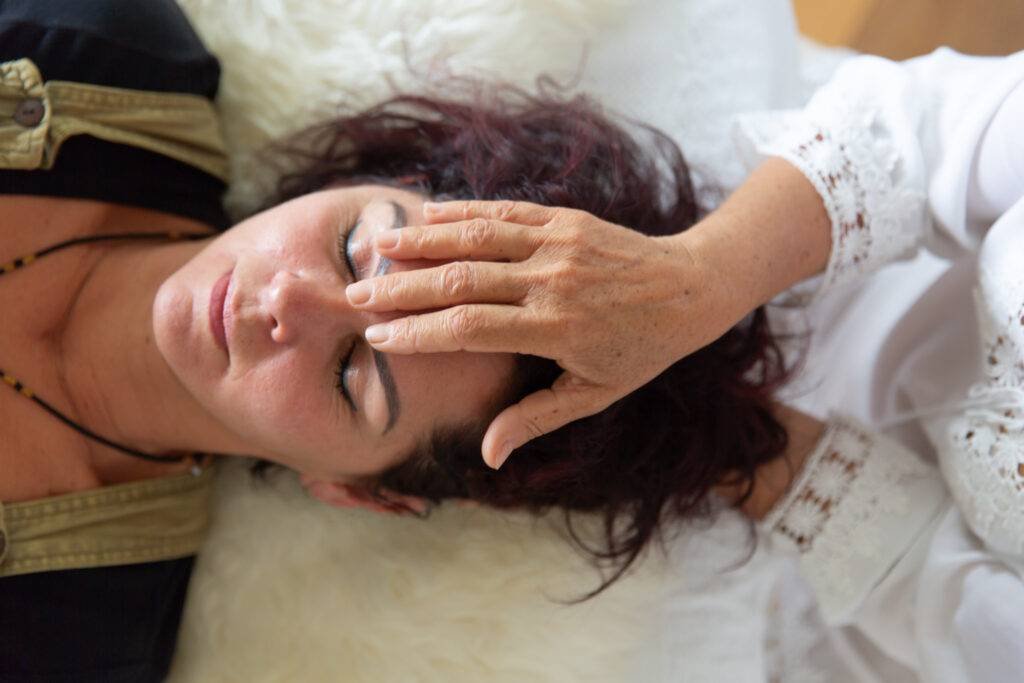No Intention, non-doing, accessing the inherent health of the body
What is Biodynamic Craniosacral Therapy?
Biodynamic Craniosacral Therapy is a form of bodywork that engages the energies that create and maintain health in the human body. While it is not a manipulative therapy, it has its roots in osteopathy and has evolved to include influences from advances in neuroscience, human development, and trauma resolution. Practitioners use an educated, non-invasive touch to listen for and to engage with the health in the system supporting nervous system regulation allowing resolution of conditions resulting from stress and trauma.

Craniosacral Therapy can address a number of issues with mind and body benefits.
People who are living with auto-immune, PTSD, anxiety, and stress disorders can also be supported through this gentle modality to discharge shock and trauma and access their own inner resources.
For people who experience overall health, this is a wonderful way to enhance the immune system and care for the whole self and body. This therapeutic work is suitable for people of all ages and physical conditions.
To receive a session, the client rests comfortably and fully clothed on the table. BCST sessions generally last 45 minutes to an hour and are guided by a natural progression initiated by the client’s own body.
“Life heals itself given the right conditions,” says Dr. Andrew Taylor Still, M.D., D.O.

Biodynamic Craniosacral Therapy Supports Pregnancy and Childbirth
During pregnancy and delivery, a woman’s body goes through a huge amount of changes, and is in constant communication with the growing baby within her. A woman’s body often “knows” what to do, but sometimes the stress and strain of delivery may complicate the process. Biodynamic Craniosacral Therapy is now being viewed as a means of helping a mother prepare for labor and delivery physically and mentally.
During pregnancy and the delivery, Biodynamic Craniosacral Therapy can help relieve pain, lower stress, and create a more positive experience for mother and child. Researchers have also revealed the following:
*Biodynamic Craniosacral Therapy has successfully been used to augment or induce labour. Mothers receiving Biodynamic Craniosacral Therapy have been shown to progress through the first stage of labor without prolonged labor.
*Interestingly, no infants born to mother’s receiving Biodynamic Craniosacral Therapy required resuscitative efforts.
*Mother’s receiving Biodynamic Craniosacral Therapy report faster healing and better adjustment compared to women who did not receive Biodynamic Craniosacral Therapy. *Women who received Craniosacral Therapy reported breastfeeding was initiated more easily.
The use of Biodynamic Craniosacral Therapy produces consistent results across studies.
Biodynamic Craniosacral Therapy Supports Antenatal care for Mother and Baby
Not only does Biodynamic Craniosacral Therapy appear to aid in better pregnancies and birth experiences, but research shows that some Biodynamic Craniosacral Therapy methods are also applicable and helpful during the postnatal period.

Consider the following:
*Using Biodynamic Craniosacral Therapy during pregnancy and/or delivery can make changes on a cellular level that will carry over into the postpartum period.
*One technique that can be considered Biodynamic Craniosacral Therapy is that of “Kangaroo Care” or the skin-to-skin bonding that many hospitals encourage, especially in NICU’s.
Biodynamic Craniosacral Therapy can be useful in helping infants latch on during breastfeeding.
*Biodynamic Craniosacral Therapy has been shown to help relieve tension and compression caused by spinal and pelvic changes during pregnancy.
Biodynamic Craniosacral Therapy for the mother has been shown to:
*Reduce fatigue
*Improve energy
*Decrease stress
*Decrease pain and inflammation
*Increase confidence
*Improve postpartum depression
In addition to these, there are currently ongoing studies examining the impact of Biodynamic Craniosacral Therapy on postnatal post-traumatic stress disorder (PTSD). While research already shows a positive correlation between Biodynamic Craniosacral Therapy and improved pregnancy and delivery outcomes, researchers note that more information and study is still needed. As with any sort of “alternative” or “non-traditional” method in a healthcare there requires a great deal of study before being integrated and exciting developments and findings are being documented with each study. For many expectant partners, Biodynamic Craniosacral Therapy may be the key to unlocking a safe, positive, and healthy pregnancy and delivery experience.

